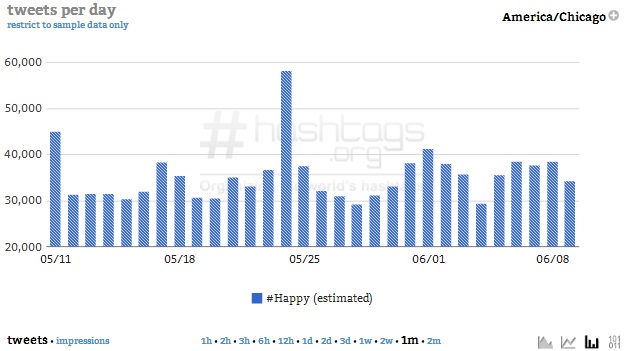
Hashtags are used for various purposes such as marketing, launching an event, talking about issues and controversies or following specific individuals.
Hashtags are also very effective in projecting emotions and letting people express themselves better. You can actually find other individuals who share the same feelings at the moment and join conversations where you can get more input and find people with similar interests.
About Hashtags for Emotions
Emotional or sentiment hashtags gives social media users an instant idea what the user is trying to say. Some of the most popular ones include
#sohappy and
#excited.
Every now and then, these topics trend well because people share what they are particularly happy or excited about in the meantime. These conversations can also be contagious and help spread the good feelings to others around.
Many individuals share photos of their current activities, videos of family and friends and other special moments in their lives such as celebrating a birthday or expecting a new baby in the house.
Here's a random example.

Other hashtags that share a person?s emotion include
#hungry and
#bored. Social media users in the office, classroom and other places use these when they have the time to tweet using their mobile devices. Others that also share the same emotion at that time will also start to join the discussion, thereby making the hashtag trend.
People talk about their food cravings and what they are currently having for lunch or breakfast. Photos also increase the attraction and encourage others to upload more images and videos. Even though these emotional hashtags may start with general topics, on some days, the conversations can get specific, as people talk about boredom in the workplace or complaints they have with colleagues and their bosses.
Increasing Hype
An emotion or sentiment hashtag also further explains or puts emphasis on tweets and posts. Uploading a simple photo then adding a hashtag will not require further words and increase the mystery or interest in the tweet or hashtag. For example, people can upload a photo of their newly served meal at a restaurant then add the hashtag #happy. The subtopic for the general emotion of being happy would then be related to food for a few hours, as other individuals also share photos of their meals during lunch time. One advantage is that several people are also very likely to be doing the same activity at the time the hashtag was used.
Let's see how #HAPPY people have been in the past month.
Social media users that incorporate emotion hashtags also present their online personality in a better way, making them more approachable to the target audience. Businesses and marketers can use these hashtags to start contests or present upcoming products and promos to help describe how people are going to feel when they see the update or advertisement.
Furthermore, sentiment hashtags do not necessarily have to be positive. Plenty of times, hashtags like
#depressed and
#irritated are used for people to vent out their anger, sadness and negative feelings. It is quite helpful for others to find individuals who share the same experience, so they can either talk about matters or ask for advice and support online.
 Hashtags are used for various purposes such as marketing, launching an event, talking about issues and controversies or following specific individuals.
Hashtags are also very effective in projecting emotions and letting people express themselves better. You can actually find other individuals who share the same feelings at the moment and join conversations where you can get more input and find people with similar interests.
Hashtags are used for various purposes such as marketing, launching an event, talking about issues and controversies or following specific individuals.
Hashtags are also very effective in projecting emotions and letting people express themselves better. You can actually find other individuals who share the same feelings at the moment and join conversations where you can get more input and find people with similar interests.
 Other hashtags that share a person?s emotion include #hungry and #bored. Social media users in the office, classroom and other places use these when they have the time to tweet using their mobile devices. Others that also share the same emotion at that time will also start to join the discussion, thereby making the hashtag trend.
People talk about their food cravings and what they are currently having for lunch or breakfast. Photos also increase the attraction and encourage others to upload more images and videos. Even though these emotional hashtags may start with general topics, on some days, the conversations can get specific, as people talk about boredom in the workplace or complaints they have with colleagues and their bosses.
Other hashtags that share a person?s emotion include #hungry and #bored. Social media users in the office, classroom and other places use these when they have the time to tweet using their mobile devices. Others that also share the same emotion at that time will also start to join the discussion, thereby making the hashtag trend.
People talk about their food cravings and what they are currently having for lunch or breakfast. Photos also increase the attraction and encourage others to upload more images and videos. Even though these emotional hashtags may start with general topics, on some days, the conversations can get specific, as people talk about boredom in the workplace or complaints they have with colleagues and their bosses.
 Courtesy of Hashtags.org Analytics
Courtesy of Hashtags.org Analytics
